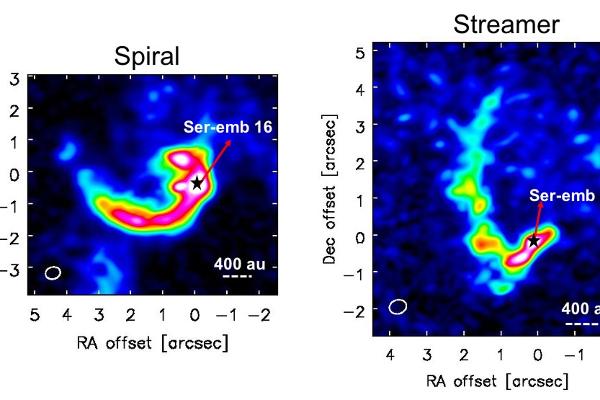The birth of stars is a chaotic and dynamic process, especially in the early phase, which is characterized by complex gas structures in the form of spirals and streamers. Such structures are termed “feeding filaments” because they feed the gaseous material from the surroundings to the newly born star, akin to cosmic umbilical cords.
Cosmic umbilical cord
News
In search of life in the universe
Read moreBrown dwarfs are celestial objects with masses less than one-tenth of the mass of the Sun. This makes them too small to undergo nuclear fusion and shine like stars. Before now, scientists did not know whether brown dwarfs form like sun-like stars or not. A test of this hypothesis requires high-sensitivity and high-angular resolution observations of brown dwarfs during their earliest formation stages. An international team led by LMU astrophysicist Dr. Basmah Riaz from the University Observatory Munich has now accomplished just that: The researchers conducted observations of the extremely young brown dwarf, Ser-emb 16, using the highly sophisticated ALMA observatory in Chile and recently published their results in the journal Monthly Notices of the Royal Astronomical Society.
“Our observations have revealed spectacular large-scale spiral and streamer structures that have never been seen before towards a newly born brown dwarf,” says Riaz. The filaments cover a vast area of about 2,000-3,000 astronomical units and are connected to Ser-emb 16. Clumps of matter were also seen around it, which themselves could potentially evolve into young brown dwarfs. “These observations show, for the first time, the influence of the external environment, which results in asymmetric mass accretion via feeding filaments on to a brown dwarf in the making,” says the astronomer.

ALMA-Beobachtungen der Spirale (links) und des Ausläufers (rechts) in Richtung des extrem jungen Braunen Zwerges Ser-emb 16.
© Basmah Riaz
Collapsing clumps or magnetic cores?
The spiral structures and streamers provide important clues about how brown dwarfs form. Having simulated possible scenarios, the researchers compared them with data from the ALMA observatory. The large structures could be explained, for example, by collisions of collapsing clumps within a star-forming region. For this to occur, such collisions would have to happen at least once during the lifetime of star-forming cores. “We have shown through new numerical simulations that collisions trigger the collapse of even small clumps to form brown dwarfs. Spirals and streamers of various sizes and morphologies form due to the collisions happening sideways, not head-on,” says co-author Dr. Dimitris Stamatellos from the University of Central Lancashire in England. If this model is correct, it implies a dynamic brown dwarf formation process, similar to Sun-like stars, where chaotic interactions in a star-forming environment are common from an early age.
News
The light of distant worlds
Read moreIn another scenario, the simulations showed that the observed structures correspond to the large (pseudo)-disk around a very young brown dwarf, where the (pseudo)-disk has been twisted by the rotation of the brown dwarf core in the presence of a strong magnetic field. If this model is correct, it means the magnetic field plays an important role in the brown dwarf formation process.
“Our ALMA observations provide a unique insight into the early formation stages of brown dwarfs”, says Riaz. A comparison of the observations with the models supports a gravitational infall scenario which can explain the asymmetric mass accretion seen in the shape of spirals and streamers, as seen around forming stars. “Consequently, Ser-emb 16 constitutes a unique case of a brown dwarf caught in the process of forming in a star-like fashion,” explains Professor Masahiro Machida from Kyushu University in Japan, also co-author of the study.
Basmah Riaz, D. Stamatellos & M. Machida: Observations of spiral and streamer on a candidate proto-brown dwarf. Monthly Notices of the Royal Astronomical Society 2024.









